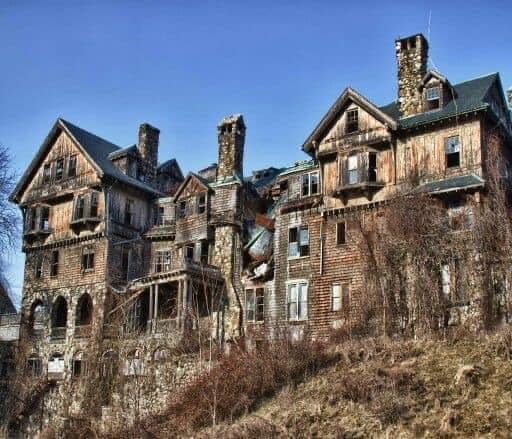Halcyon Hall, also known as Bennett College, is a fascinating piece of architectural history located in Millbrook, New York. Once a thriving women’s college, the grand building now stands abandoned, shrouded in mystery and intrigue.
Constructed in the early 20th century, Halcyon Hall was designed by architect James E. Ware in the Tudor Revival style. With its striking façade, expansive grounds, and ornate interior features, the building exuded an aura of grandeur and sophistication.
Bennett College, named after its founder, May F. Bennett, opened its doors in 1890 as a school for young women seeking higher education. Over the years, it expanded its curriculum and facilities, becoming a well-regarded institution known for its focus on liberal arts and sciences.
However, as the 20th century progressed, Bennett College faced financial difficulties and declining enrollment. The college struggled to adapt to changing educational trends and economic challenges, eventually leading to its closure in 1978.
Since then, Halcyon Hall has stood empty, its once-vibrant halls and classrooms left to decay and decay. Despite its abandonment, the building continues to captivate urban explorers, photographers, and enthusiasts of abandoned architecture.
Over the years, various proposals and plans have been put forward for the redevelopment or restoration of Halcyon Hall, but none have come to fruition. Today, the building remains a haunting reminder of a bygone era, its faded glory serving as a testament to the passage of time.
Exploring Halcyon Hall offers a glimpse into the past, allowing visitors to imagine the lives of the students and faculty who once walked its halls. While the building may be empty, its history and architectural significance endure, ensuring that Halcyon Hall remains an intriguing landmark for generations to come.

Halcyon Hall’s abandonment has fueled numerous rumors and urban legends, adding to its mystique. Some claim the building is haunted, with stories of ghostly apparitions and eerie sounds echoing through its empty corridors. These tales have attracted paranormal enthusiasts, further adding to the allure of the abandoned site.
Despite its dilapidated state, Halcyon Hall retains much of its architectural beauty. Its intricate stonework, soaring towers, and grand windows still hint at its former grandeur, even as nature slowly reclaims the surrounding landscape.
In recent years, there have been sporadic efforts to explore possibilities for the restoration or adaptive reuse of Halcyon Hall. Some proposals have suggested converting the building into a hotel, conference center, or residential complex. However, the immense cost and logistical challenges involved in such endeavors have thus far hindered any concrete progress.
While the future of Halcyon Hall remains uncertain, its allure as an abandoned landmark continues to draw curiosity-seekers and preservationists alike. The site serves as a poignant reminder of the fragility of architectural heritage and the importance of preserving our cultural landmarks for future generations to appreciate and enjoy.
In addition to its architectural and historical significance, Halcyon Hall has also been the subject of artistic exploration. Photographers, filmmakers, and writers have been drawn to its haunting beauty, using it as a backdrop for their creative endeavors.
Photographers, in particular, have captured the allure of Halcyon Hall through striking images that juxtapose its decaying splendor with the surrounding natural landscape. These photographs often evoke a sense of melancholy and nostalgia, inviting viewers to contemplate the passage of time and the stories embedded within the abandoned walls.
Filmmakers have also been inspired by Halcyon Hall’s eerie ambiance, using it as a setting for atmospheric scenes in documentaries, short films, and music videos. Its crumbling interiors and overgrown surroundings provide a visually captivating backdrop for storytelling, whether exploring themes of abandonment, memory, or the supernatural.
Writers, too, have been intrigued by the mysteries of Halcyon Hall, weaving its enigmatic presence into their narratives. Whether in fiction or non-fiction, the abandoned building serves as a symbol of lost dreams, forgotten histories, and the enduring power of the past to haunt the present.
Overall, Halcyon Hall’s abandonment has not only sparked fascination but also served as a muse for creative expression across various artistic mediums. Its allure as a cultural landmark continues to resonate, inspiring ongoing exploration, interpretation, and preservation efforts.
Architectural Details: Delving into the architectural features of Halcyon Hall could provide insights into its design, construction methods, and the materials used. Examining blueprints, building permits, or architectural records may reveal hidden details about the structure and its significance within the broader context of architectural history.
Social and Cultural Context: Exploring the social and cultural context of Halcyon Hall’s heyday as Bennett College could shed light on the experiences of the students, faculty, and staff who inhabited the building. Investigating yearbooks, alumni records, and oral histories may uncover personal anecdotes, traditions, and memories associated with the college and its community.
Ownership and Legal History: Researching the ownership history of Halcyon Hall and any legal disputes or transactions related to the property could provide additional context for its abandonment and current status. Examining property records, deeds, and court documents may reveal key events or decisions that shaped the building’s fate over time.
Local Legends and Folklore: Beyond documented history, exploring local legends, folklore, and urban myths associated with Halcyon Hall could offer alternative perspectives on its significance and cultural impact. Investigating stories passed down through generations or documented in local lore may uncover hidden truths or symbolic interpretations of the building’s legacy.
Environmental Impact and Conservation Efforts: Assessing the environmental impact of Halcyon Hall’s abandonment and exploring potential conservation efforts aimed at preserving the building’s architectural integrity and surrounding ecosystem could offer insights into its future trajectory. Studying environmental reports, conservation plans, or community initiatives may reveal ongoing efforts to protect and revitalize the site for future generations.
By exploring these additional aspects of Halcyon Hall’s history and legacy, researchers, historians, and enthusiasts can gain a more comprehensive understanding of its significance and the broader implications of its preservation or redevelopment.
